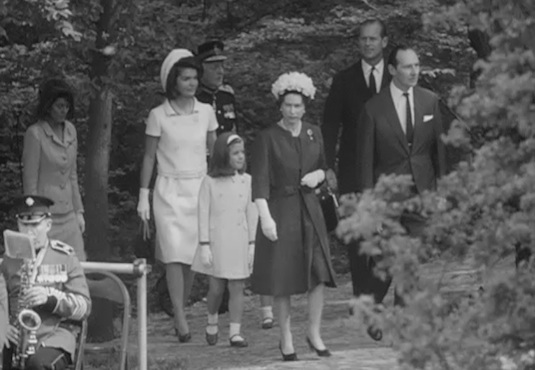***THE KENNEDY SCHOLARSHIP COMPETITION FOR 2024-25 HAS NOW CLOSED.
DETAILS OF THE 2025-26 COMPETITION WILL BE MADE AVAILABLE NEXT SUMMER.***
The Kennedy Memorial Trust was founded in 1964 to oversee the official British national memorial to US President John F. Kennedy. That memorial has two parts, 'a memorial in landscape and stone' at Runnymede in Surrey and a 'living memorial' in the form of Kennedy Scholarships to Harvard University and the Massachusetts Institute of Technology (MIT). Offered each year since 1965, more than 570 British postgraduates have received these distinguished and transformative awards.
Learn more about the Kennedy Scholarship programme here, and find out how to apply.
Why is there a British memorial to President Kennedy?
In his speech at the inauguration of the Kennedy Memorial at Runnymede in May 1965, Harold Macmillan first spoke of the anger and grief, the ‘bitterness of the loss of one of those rare personalities who seemed born to bridge the gulf dividing races and creeds and help to build the unity of all mankind.’ He then noted that the bereavement was not just a public disaster but ‘to each one of us, a personal, individual, private grief’. Her Majesty the Queen said: ‘The unprecedented intensity of that wave of grief, mixed with something akin to despair, which swept over our people at the news of President Kennedy’s assassination, was a measure of the extent to which we recognised what he had already accomplished, and of the high hopes that rode with him in a future that was not to be.’
Only twenty years after the end of World War Two, President Kennedy articulated a re-energised vision for world peace, and a renewed vision for public service in which the individual was again encouraged to believe that even a necessarily limited area of engagement in the world could contribute to the common good. Harold Wilson commented: ‘His life brought new hope and vitality to a tired world.’
These twin strands – the breadth of his vision coupled with his oratory in calling for action, alongside the vigour and attractiveness of his personality – meant that his assassination evoked more than simply shock at so brutal a death. Television ensured that Kennedy’s speeches - and their particular energy - had been widely heard; his personal charm had been experienced in people’s homes. To quote the Queen again: ‘Abroad, peace for a shrinking world; at home, a just and compassionate society. These were the themes of his Presidency. But it is his own example as a man that we remember…his courage, both moral and physical; his dedication to public service; the distinction of heart and mind, the joyful enthusiasm, the wit and style which he brought to all he did; his love of liberty and of his fellow men.' Out of this profound sense of loss, a number of funds were started in Britain, and on 5th December 1963 the Prime Minister, Sir Alec Douglas-Home, having consulted with the leaders of the Labour and Liberal parties, announced that he would be establishing a committee chaired by Lord Franks, a former British Ambassador to Washington, to recommend the form an appropriate British memorial should take. Subsequently, a national appeal for funds was launched by the then Lord Mayor of London, Sir James Harman.

To read the full text of the speeches made on 14th May, 1965 please click here.
To watch archive footage of the memorial inauguration ceremony, click here.
To see photos of the Commemoration held on 22nd November 2013 click here
What is the British memorial to President Kennedy?
The memorial has two expressions. Sir Geoffrey Jellicoe was commissioned to design ‘a memorial in landscape and stone’ on Crown land at Runnymede which was, in May 1965, bequeathed to the American people in perpetuity under the control and management of the Kennedy Memorial Trust. (Runnymede was seen as a particularly appropriate location given the signing of Magna Carta there in 1215, the foundational document for English – and American – civil liberties.) In addition, it was agreed that a ‘living memorial’ consisting of scholarships for British graduate students would be established, ‘thereby recalling the President’s interest in bringing into fruitful combination the disciplines of traditional humane studies and modern technology and so making their strength effective in the activities of government and in the direction of world affairs.’
Senator Edward Kennedy, speaking in May 1964, called the establishing of the Kennedy Scholarships ‘the most ambitious’ of all the memorials and, in a private conversation in 2001, referred to them as ‘something I just know that President Kennedy, my brother, would have valued very, very highly’. At Runnymede in May 1965, Harold Macmillan explained: ‘The second object, to which the bulk of the funds will be devoted, is the foundation of the Kennedy Scholarships….There will thus be, through the coming years, a succession of Kennedy Scholars who will keep his memory fresh and fruitful in a field perhaps closest to him – among young men and women – young people of parts and promise, whose lives, we trust, will be devoted to the causes he had at heart.’
The Runnymede Memorial was inaugurated by the Queen in May 1965 and the first group of Kennedy Scholars went over to Harvard and MIT to begin their courses of study in September 1966.
Since then, more than 550 British students have been awarded Kennedy Scholarships. Many have gone on to distinguish themselves in academia, public service, the professions, politics, the media, business and other varied careers.
Every autumn a national competition takes place to select the next group of Scholars for the following academic year. The Trustees are keen to attract a strong and diverse field of candidates from throughout the UK.